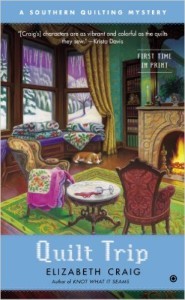Writing Solo after Being Collaborative
By Elizabeth S. Craig, @elizabethscraig
For the first time, I’m writing one of the Southern Quilting mysteries on my own. I got the rights to my characters back from Penguin Random House last year.
Although I was excited to keep writing the characters and their adventures, it’s been a bit unsettling. I wasn’t expecting to feel unsettled since this is the second series that I’ve gotten my rights back for.
But the first series had only one book traditionally published before I started self-publishing the rest. This series had a good five books in it.
What’s more, I had written the Southern Quilting series as a collaborative effort with my editor. We’d bounce around a few ideas, I’d send her an outline, she’d give her (always very thoughtful) opinion on it, and I’d usually make changes—small and large—before writing the manuscript.
The more I think about it, the more I recognize what a huge part she played in the series.
I’m far more used to being a lone wolf writer than a collaborative one. I’ve written something like fourteen books with minimal editorial input. With the exception of this one series.
Unfortunately, my editor was laid off from Penguin-Random House last summer, one of many victims of the merger.
The series, despite the fact that Penguin was pushing a digital-only contract on me last year, was successful. I get emails regularly from readers who enjoyed the books and are asking when the next one is coming out.
What I wonder is—what parts of the books were the readers resonating most with? Because my editor and I had very different areas that we focused on.
For instance, my editor was especially keen on adding lots of textual detail to the books. They are the Southern Quilting books. If I didn’t include enough quilting scenes, she’d ask me to include more. She promised me my readers would especially enjoy them.
I was always pretty restless with these requests. I’d honor them, but I also slipped in a hefty amount of plot or character development at the same time. Perhaps Beatrice was working on a batik fabric in an arrowhead variation block. But she was casting arrows at a potential suspect at the same time.
My editor also cared a lot about the settings and wanted more detail than I usually give. I did provide a lot more at her request. She also added a Yankee sensibility to my Southern books. She stopped me when there was something she didn’t understand or when she needed more information on a throwaway word that I thought everyone knew.
Clogging? What’s that? she asked.
A type of folk dance that’s popular in the mountain towns of the South, I wrote back with a mental shrug.
Can you describe it? she asked.
Describe clogging??
There were also recipes and quilting tips at the backs of the books, which my editor had expressly asked me to include.
As I’ve been working, solo, on this new book, I’ve been writing it as I usually would. Without all the extra detail. I’d always add the detail in later, in a separate layer of writing. I’m wondering, now, how faithful I’ll be to the way I wrote the previous books. Will I focus as much on the quilting subplots? Should I? Can I leave out the recipes and quilting tips or will I be dinged in the reviews for that—I do see readers mentioning them in customer reviews. Clearly I should be more careful with my Southernisms, too.
Has your relationship with an editor ever bordered on collaborative? Or have you co-written with another author?
Going solo with a series after collaborative writing with an editor:
Click To Tweet
The post Writing Solo after Being Collaborative appeared first on Elizabeth Spann Craig.



